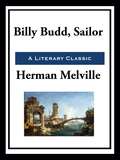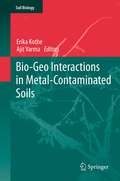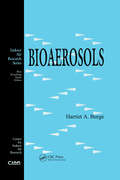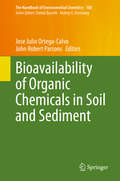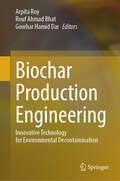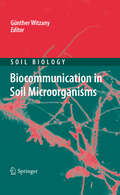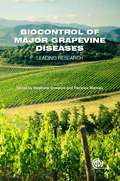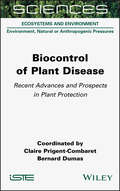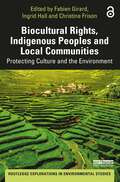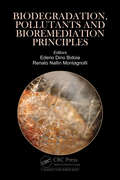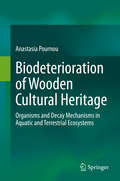- Table View
- List View
Billy Budd: Downloadable Teaching Unit (Sparknotes Literature Study Guides)
by Herman MelvilleWhile 'Moby Dick' is Herman Melville&’s best known book, 'Billy Budd, Sailor' is considered by many to be his greatest work. Billy, a foundling from Bristol, has an innocence, good looks and a natural charisma that make him popular with the crew. His only physical defect is a stutter which grows worse when under intense emotion. He arouses the antagonism of the ship&’s master-at-arms, John Claggart. Claggart, while not unattractive, seems somehow defective or abnormal next to Billy. Despite Claggart&’s animosity towards him, Billy saves Claggart&’s life further infuriating the man. Claggart then accuses Billy of conspiring to mutiny. Billy, dumfounded by the accusation, becomes unable to defend himself against Claggart&’s words because of his stuttering and in frustration strikes the lying Claggart with a blow so powerful that it kills the man instantly. In the ensuing trial Melville explores good and evil, justices and mercy, right and wrong, and natural law verses man&’s law. A Masterpiece for the Ages!
Bio-Geo Interactions in Metal-Contaminated Soils (Soil Biology #31)
by Ajit Varma Erika KotheMetal contamination is an increasing ecological and eco-toxicological risk. Understanding the processes involved in metal mobilization, sorption and mineralization in soils are key features for soil bioremediation. Following an introduction to the physical, chemical and biological components of contaminated soils, various chapters address the interactions of soil, microorganisms, plants and the water phase necessary to transfer metals into biological systems. These include topics such as potential hazards at mining sites; rare earth elements in biotic and abiotic acidic systems; manganese redox reactions; biomineralisation, uranium in seepage water; metal-resistant streptomycetes; mycorrhiza in re-forestation; metal (hyper)accummulation in plants; microbial metal uptake; and their potential for bioremediation. This book will be of interest to soil biologists, geologists and chemists, researchers and graduate students, as well as consulting companies and small enterprises involved in bioremediation.
Bioactive Compounds Extraction from Marine Resources and Wastes (Interdisciplinary Biotechnological Advances)
by J. Basilio Heredia Erick Paul Gutiérrez-Grijalva Luis Angel Cabanillas-BojórquezThis book provides information about the principal biotechnological strategies (enzyme-assisted extraction, liquid fermentation, and solid-state fermentation) used for the bioactive compounds (bioactive peptides, carotenoids, phenolic acids, polyunsaturated fatty acids, vitamins, and minerals, among others) extraction from the marine resource (marine animals, microalgae, seaweed, among others) and wastes (crustaceans, fish, and others). This book also highlights the importance of bioactive compounds in marine resources and wastes and the perspectives for a potential industrial application. This book is oriented to researchers related to marine resources and marine wastes, who apply their knowledge in the innovation of the extraction and application of bioactive compounds from these sources. Moreover, this book will also provide knowledge and areas of opportunity for entrepreneurs, different industries, and the development of new products that could be used in the overall improvement of different areas such as human health.
Bioaerosols (Indoor Air Research Ser. #2)
by Harriet A. BurgeWritten by an illustrious group of experts in microbiology and aerobiology, Bioaerosols brings together current information on the nature and health effects of bioaerosol-related problems. The book presents up-to-date coverage of methods for sampling and analysis, as well as various approaches to the investigation of health problems caused by exposure to biological contaminants in indoor air. Its comprehensive treatment of the various aspects of this subject makes it a valuable reference for industrial hygienists, public health officials and researchers, and physicians interested in environmentally caused disease.
Bioaugmentation, Biostimulation and Biocontrol (Soil Biology #10)
by Ajay Singh Ramesh C. Kuhad Nagina ParmarBioaugmentation, biostimulation and biocontrol approaches using microbial inoculants, biofertilizers, biochemicals and organic amendments improve soil biology, fertility and crop productivity by providing plant growth-promoting nutrients and suppressing soil-borne diseases and plant-parasitic nematodes. Our knowledge of microbial diversity and its function in soils has been increased tremendously due to the availability of a wealth of data gained through recent advances in the development of molecular methods and metagenomics for the evaluation of microbial diversity and functions in the rhizosphere environment of soil. Chapters dealing with the application of biofertilizers and organic amendments are contributed by experts - authorities in the area of soil science including microbiology and molecular biology - from academic institutions and the industry.
Bioavailability of Organic Chemicals in Soil and Sediment (The Handbook of Environmental Chemistry #100)
by Jose Julio Ortega-Calvo John Robert ParsonsThis book discusses bioavailability concepts and methods, summarizing the current knowledge on bioavailability science, as well as possible pathways for integrating bioavailability into risk assessment and the regulation of organic chemicals. Divided into 5 parts, it begins with an overview of chemical distribution in soil and sediment, as well as the bioavailability and bioaccumulation of chemicals in plants, soil, invertebrates and vertebrates (including humans). It then focuses on the impact of sorption processes and reviews bioavailability measurement methods. The closing chapters discuss the impact of bioavailability studies on chemical risk assessment, and highlights further research needs. Written by a multi-disciplinary team of authors, it is an essential resource for scientists in academia and industry, students, as well as for authorities.
Bioblitz!
by Susan Edwards RichmondA young boy and his cousin compete to identify the most different species on a biodiversity count day at a local parkYou might be amazed at the large number of insects, birds, and small mammals that inhabit even a very small plot of land. In this story Gabriel's dad, a ranger for the local municipal park, is helping with a Biodiversity Day (or Bioblitz), and he invites Gabriel and his cousin Ava to participate. With Gabriel's expertise in bugs and Ava's eye for birds, the two cousins are eager to start the hunt in the park. They are placed on different teams, competing to see which group finds the most species of animal life in the time allotted.Readers follow the two teams through a variety of habitats, where they spot dozens of different species over the course of the day. Kids will enjoy finding all the species (some are hidden in the illustration) that appear on the lists compiled in each habitat. Several different techniques for viewing species—rolling logs to discover critters living underneath and shining lights on white sheets at night to attract moths, for example—are highlighted.Plot action in this community science adventure revolves around the competition between the cousins, who check in with each other at intervals to compare lists. In the end, Ava's team spots one more species than Gabriel's, but Gabriel earns a special award for discovering a species of special concern in their area, a blue-spotted salamander. Because of all they have learned from the Bioblitz, the cousins realize that the real winner is the park and all its visitors. After reading Bioblitz!, students—as well as their parents and teachers—will be eager to participate in a biodiversity day in their own community!
Biochar
by Bruckman Viktor J. Varol Esin Apaydın Uzun Başak B. Jay LiuClimate change poses a fundamental threat to humanity, and thus solutions for both mitigation and adaptation strategies are becoming increasingly necessary. Biochar can offer a range of environmental services, such as reclamation of degraded land, improvement of soil fertility and carbon sequestration. However, it also raises questions, regarding sustainable feedstock provision, biomass pyrolysis, and soil amendment. These questions, among various others, are addressed in this state-of-the-art compendium. Covering a broad geographical range, with regional assessments from North America, Europe, the Near East, and Southeast Asia, this interdisciplinary volume focuses on the entire biochar supply chain, from the availability and economics of biomass resources, to pyrolysis, and ultimately to the impacts on soil properties. The combination of theory with practical examples makes this a valuable book for researchers, policymakers, and graduate students alike, in fields such as soil science, sustainable development, climate change mitigation, biomass and bioenergy, forestry, and environmental engineering.
Biochar Applications in Agriculture and Environment Management
by Jay Shankar Singh Chhatarpal SinghThis book provides up-to-date information on biochar use in management of soil health, agriculture productivity, green-house gases, restoration ecology and environment. Biochar application to nutrient deficient and disturbed soils is a viable option which may promotes advances in food safety and food security to human nutrition and overall fundamental research in the agricultural sciences. The book describes in detail how the recalcitrant biochar is able to persist for long periods of time and work as a shelter for soil microbial colonisation and their biomass/numbers. This book also includes contents related to important role of biochar applications in the restoration of contaminated agricultural soils. The book will be of particular interest to students, teachers and researchers in the disciplines.
Biochar Production Engineering: Innovative Technology for Environmental Decontamination
by Rouf Ahmad Bhat Gowhar Hamid Dar Arpita Roy&“Biochar Production Engineering - Innovative Technology for Environmental Decontamination&” covers biochar production from different materials. The book discusses comprehensively the compatibility of biochar for cleaning up contamination from different environments. In addition, the book also reconnoiters various eco-friendly, economical, and aesthetically acceptable biochar-based decontamination technologies. The book alluringly highlights the cutting-edge investigation in this field and provides intriguing data on the biochar application for the treatment of various kinds of pollutants to restore the ecosystem features and consequently reveal newfangled scopes of biochar application. Key Features Provides various methods and strategies for biochar production from different raw materials and their physicochemical properties. Investigation in relation to compatibility of biochar as pollution decontamination tool. Address current trends and challenges related to the biochar production and economic aspects of biochar and its use in pollution remediation.
Biochar for Environmental Management: Science, Technology and Implementation
by Stephen JosephFully revised and updated for its third edition, this book presents the definitive compilation of current knowledge on all aspects of biochar.Research on biochar continues to accelerate as its importance for soil health, climate change mitigation and adoption, and the circular economy becomes more widely acknowledged. This book not only reviews recent advances made in our understanding of biochar properties, behavior, and effects in agriculture, environmental management, and material production, but specifically develops fundamental principles and frameworks of biochar science and application. This third edition has been fully revised and updated to reflect recent developments and growing trends, with important coverage of the application of biochar outside of its traditional soil-based uses, the commercialization of biochar, and its incorporation into policy. This includes brand new chapters on the role of biochar-based materials for environmental remediation, building construction, and animal feed, and a greater discussion of biochar's role in the circular economy, climate change mitigation, and sustainable development. Overall, this book provides a systematic, comprehensive, and global examination of biochar. Written by an international team of academics and professionals, it addresses its uses, production, and management and its broader potential for mitigating climate change and driving forward sustainable development.Edited by two leading figures in the field, Biochar for Environmental Management is essential reading for students, scholars, practitioners, and policymakers interested in biochar and the role it can play in environmental sustainability and global sustainable development.Chapter 16 of this book is freely available as a downloadable Open Access PDF at http://www.taylorfrancis.com under a Creative Commons Attribution-Non Commercial-No Derivatives (CC-BY-NC-ND) 4.0 license.
Biocidal
by Ted DracosIn 1962, Rachel Carson stunned the world with the publication of Silent Spring, exposing the lethal character of the pesticide DDT. Her work launched a global campaign against synthetic chemical toxins and veritably created a world environmental movement. But unbeknownst to Carson, an even more insidious chemical cousin to DDT had been silently poisoning the biosphere. Polychlorinated biphenyls (PCBs) were first manufactured in 1920. Seen as a “magic fluid,” they were a cheap and stable heat-transfer material used as a critical coolant in big power grids. The chemical industry soon went on to develop hundreds of other uses for this highly toxic group of substances—everything from copy paper and paint to hydraulic fluids. Despite being outlawed in the U.S. since 1976, PCBs are currently found in the remotest corners of Earth and remain the most prevalent group of industrial chemical contaminants in much of the world. Every human being, from the womb to the grave, bears a body burden of these poisonous molecules forever locked in their blood and tissues. In Biocidal, investigative journalist Ted Dracos tells the full story of PCBs for the first time, starting with the chilling chronicle of how the chemical industry manipulated regulatory agencies and scientific findings for decades to continue to reap huge profits, despite their knowledge of the threats posed by their “magic fluid.” Dracos draws on extensive research to document the connection between PCBs and catastrophic human illness, presenting the latest science as studies draw ever more disturbing links between PCBs and continued health impacts ranging from cancer and autism to immunosuppression and reproductive abnormalities. Biocidal also explores the science behind the threat PCBs pose to Earth’s biodiversity: today, killer whales in the Puget Sound are dying, the eggs of Ontario Lake trout are doomed before they can hatch, 99 percent of the freshwater eels of Europe have disappeared, and frogs around the world are going extinct. While these disasters have many possible causes, evidence pointing to PCBs keeps accumulating, much like the toxins in these animals’ systems. Nonetheless, Dracos leaves readers with a profound message of hope: the damage is not irreversible. In fact, cleanup efforts that involve the removal of the source of PCBs can really work, and quickly. Offering a simple blueprint for steps that can be taken to reduce the impacts of all industrial chemicals, Biocidal ultimately points the way toward a detoxified world.
Biocivilisations: A New Look at the Science of Life
by Predrag B. Slijepčević*2024 Nautilus Book Award Gold Medal Winner: Restorative Earth Practices "A brilliant book [that] shows a way out of the destructive trap of Anthropocentric arrogance."—Vandana Shiva, author of Terra Viva "An unusually thought-provoking and ambitious book."—Dr. James A. Shapiro, author of Evolution: A View from the 21st Century Biocivilisations is an important, original rethinking of the mystery of life and its deep uncertainty, exploring the complex civilisations that existed on Earth long before humans. What is life? Many scientists believe life can be reduced to ‘mechanistic’ factors, such as genes and information codes. Yet there is a growing army of scientists, philosophers and artists who reject this view. The gene metaphor is not only too simplistic but deeply misleading. If there is a way to reduce life to a single principle, that principle must acknowledge the creativity of life, turning genetic determinism on its head. The term biocivilisations is the acknowledgement of this uncertainty of life, as opposed to a quasi-certainty of the human position governed by a narrow time window of the scientific revolution. Life existed without humans for more than 99.99 percent of the Earth’s existence. Life will also continue without humans long after our inevitable extinction. In Biocivilisations, Dr Predrag Slijepčević shows how bacteria, amoebas, plants, insects, birds, whales, elephants and countless other species not only preceded human beings but demonstrate elements of how we celebrate human civilisation – complex communication, agriculture, science, art, medicine and more. Humans must try to adopt this wisdom from other biocivilisations that have long preceded our own. By rethinking the current scientific paradigm, Dr Slijepčević makes clear that a transformation – from a naïve young species into a more mature species in tune with its surroundings – will save us from our own violence and the violence we inflict on the rest of our living planet. "Read this book if you would like to understand the intelligence of living systems."—Dr Denis Noble, University of Oxford
Biocommunication in Soil Microorganisms (Soil Biology #23)
by Günther WitzanyCommunication is defined as an interaction between at least two living agents which share a repertoire of signs. These are combined according to syntactic, semantic and context-dependent, pragmatic rules in order to coordinate behavior. This volume deals with the important roles of soil bacteria in parasitic and symbiotic interactions with viruses, plants, animals and fungi. Starting with a general overview of the key levels of communication between bacteria, further reviews examine the various aspects of intracellular as well as intercellular biocommunication between soil microorganisms. This includes the various levels of biocommunication between phages and bacteria, between soil algae and bacteria, and between bacteria, fungi and plants in the rhizosphere, the role of plasmids and transposons, horizontal gene transfer, quorum sensing and quorum quenching, bacterial-host cohabitation, phage-mediated genetic exchange and soil viral ecology.
Biocontrol of Major Grapevine Diseases: Leading Research
by Florence Mathieu Stéphane CompantBiocontrol of major grapevine diseases provides a timely research update on the use of biological control agents and plant resistance inducers against phytopathogenic infections of the grapevine by fungi, oomycetes, bacteria and phytoplasma.Taking a holistic approach, this book presents in detail the ecology, mechanisms and the application methods of these agents. Its 19 chapters, authored by international experts, cover diseases such as grey mould, trunk diseases, powdery and downy mildews, as well as phytoplasma diseases, and, by nature, emphasise applications of biocontrol in organic viticulture and as part of integrated pest management systems.
Biocontrol of Major Grapevine Diseases: Leading Research
by Florence Mathieu Stéphane CompantThis book provides a thorough research update on the very topical subject of biological control of grapevine diseases. It covers fungi, oomycete, bacteria and phytoplasma, and is particularly relevant to organic viticulture but also beneficial as part of IPM strategies for traditional production.
Biocontrol of Plant Disease: Recent Advances and Prospects in Plant Protection
by Claire Prigent-Combaret Bernard DumasFaced with climate changes, pest pressure on plants is increasing and new pest complexes are appearing, for which plant protection solutions are not yet available. The reduction of anthropic pressure on agroecosystems requires a reduction in the use of chemical inputs and the promotion of biocontrol approaches. <p><p> In this book, we present new advances on plant disease management that are emerging from research outputs. The ability of biocontrol products to directly (e.g. production of antimicrobial peptides or quorum quenching activities by microorganisms, use of plant or agro-industrial by-products as biopesticides, etc.) or indirectly (e.g. via the increase of plant defense or plant growth pathways) protect plants against pathogens and pests is also considered. <p><p> We also address new strategies like the development of phage-based biocontrol products and those that consider the plant as a holobiont and plant microbiota as targets of biocontrol treatments. The important question of the current regulatory process needed to launch plant production products on the market is also addressed, such as methods to evaluate their environmental impact.
Biocultural Landscapes: Diversity, Functions and Values
by Sun-Kee Hong Jan Bogaert Qingwen MinThis book is devoted to the cultural and biological dimensions and values of landscapes, linking the concepts of biodiversity, landscape and culture and presenting an essential approach for landscape analysis, interpretation and sustainable dynamics. Early chapters explore the concepts and values of biocultural landscapes, before addressing the methodology to identify the relationship between biological and cultural diversity. The volume continuous with a series of case studies and with an exploration of the key role of biocultural diversity in contemporary landscape ecology. Readers will learn the importance of landscapes for different fields of natural and human sciences and are confronted to the trans-disciplinary nature of the landscape concept itself. A hierarchical approach to landscapes, in which they are composed of interacting (eco)systems, is shown to be essential in recognizing their emergent properties. In this work, the biocultural values of landscapes are explored through their diversity in geographical scopes, methodological approaches and conceptual assumptions. Authors from Asia, Europe and North-America present diverse research experiences and views on biocultural landscapes, their pattern, conservation and management. Landscape ecologists will find this work particularly appealing, as well as anyone with an interest in sustainable landscape development, nature conservation or cultural heritage management. This volume is the outcome of a symposium on "Biodiversity in Cultural Landscapes", organized in the framework of the 8th IALE World Congress, held in Beijing in 2011.
Biocultural Rights, Indigenous Peoples and Local Communities: Protecting Culture and the Environment (Routledge Explorations in Environmental Studies)
by Fabien GirardThis volume presents a comprehensive overview of biocultural rights, examining how we can promote the role of indigenous peoples and local communities as environmental stewards and how we can ensure that their ways of life are protected. With Biocultural Community Protocols (BCPs) or Community Protocols (CPs) being increasingly seen as a powerful way of tackling this immense challenge, this book investigates these new instruments and considers the lessons that can be learnt about the situation of indigenous peoples and local communities. It opens with theoretical insights which provide the reader with foundational concepts such as biocultural diversity, biocultural rights and community rule-making. In Part Two, the book moves on to community protocols within the Access Benefit Sharing (ABS) context, while taking a glimpse into the nature and role of community protocols beyond issues of access to genetic resources and traditional knowledge. A thorough review of specific cases drawn from field-based research around the world is presented in this part. Comprehensive chapters also explore the negotiation process and raise stimulating questions about the role of international brokers and organizations and the way they can use BCPs/CPs as disciplinary tools for national and regional planning or to serve powerful institutional interests. Finally, the third part of the book considers whether BCPs/CPs, notably through their emphasis on "stewardship of nature" and "tradition", can be seen as problematic arrangements that constrain indigenous peoples within the Western imagination, without any hope of them reconstructing their identities according to their own visions, or whether they can be seen as political tools and representational strategies used by indigenous peoples in their struggle for greater rights to their land, territories and resources, and for more political space. This volume will be of great interest to students and scholars of environmental law, indigenous peoples, biodiversity conservation and environmental anthropology. It will also be of great use to professionals and policymakers involved in environmental management and the protection of indigenous rights. The Open Access version of this book, available at www.taylorfrancis.com, has been made available under a Creative Commons Attribution-Non Commercial-No Derivatives 4.0 license
Biodegradation, Pollutants and Bioremediation Principles
by Ederio Dino BidoiaThis book presents a broad compendium of biodegradation research and discussions on the most up-to-date bioremediation strategies. The most relevant microbiological, biochemical and genetic concepts are presented alongside the fundamentals of bioremediation. The topics include: a wide variety of contaminant impacts evaluation, key methodologies required to measure biodegradation and propose new bioremediation protocols, as well as the handling of microbial communities related to such processes. The selected collaborating authors are renowned for their microbiology expertise and will provide an in-depth reference for students and specialists. The contents provide a valuable source of information for researchers, professionals, and policy makers alike.
Biodeterioration of Wooden Cultural Heritage: Organisms and Decay Mechanisms in Aquatic and Terrestrial Ecosystems
by Anastasia PournouSince prehistoric times and throughout the course of human evolution, wood has been an integral part of all civilizations. Wooden Cultural Heritage can be found worldwide, providing valuable information on the social and economic context of human history. Nonetheless, as a natural cellulosic material, wood shows low resistance to biodeterioration and thus wooden Cultural Heritage often fails to escape decomposition in both aquatic and terrestrial ecosystems. This book provides a comprehensive overview on the biodeterioration of wooden Cultural Heritage and describes the decay mechanisms of key organisms and microorganisms encountered in aquatic and terrestrial ecosystems. Cultural Heritage professionals, researchers and academics may explore within this book the associations between deteriogens, habitats and decay, which will assist them to understand wood biodeterioration and design effective prevention, mitigation and remediation strategies. The book presents case studies around the world to demonstrate the impact of biogenic deterioration on wooden Cultural Heritage and illustrates mechanisms and patterns in order to be a useful handbook of decay diagnosis.Lastly, by adopting a holistic approach to wood decay, basic concepts of wood technology, ecology, and deteriogens' biology are introduced, permitting readers of different scientific backgrounds to easily comprehend wood biodeterioration.
Biodiesel
by Greg PahlFor anyone who is trying to keep up with the extremely rapid developments in the biodiesel industry, the second edition of Biodiesel: Growing a New Energy Economy is an invaluable aid. The breathtaking speed with which biodiesel has gained acceptance in the marketplace in the past few years has been exceeded only by the proliferation of biodiesel production facilities around the United States-and the world-only to confront new social and environmental challenges and criticisms. The international survey of the biodiesel industry has been expanded from 40 to more than 80 countries, reflecting the spectacular growth of the industry around the world. This section also tracks the dramatic shifts in the fortunes of the industry that have taken place in some of these nations. The detailed chapters that cover the industry in the United States have also been substantially rewritten to keep abreast of its many new developments and explosive domestic growth. An expanded section on small-scale, local biodiesel production has been added to better represent this small but growing part of the industry. Another new section has been added to more fully explore the increasingly controversial issues of deforestation and food versus fuel, as well as GMO crops. The second edition concludes with updated views on where the industry is headed in the years to come from some of its key players.
Biodiversity Conservation Through Access and Benefit Sharing (ABS): Himalayas and Indian Sub-Continent
by K. P. Laladhas Oommen V. Oommen Prakash Nelliyat Balakrishna PisupatiThis book deals with the economic potentials of biodiversity and its capacity to support its own conservation aiming to provide livelihood for millions engaged in conservation, both now and for future generations. The book highlights the potentials of natural resources which are characterized as capital wealth (as defined in Convention on Biological Diversity (CBD)), to finance its own conservation and to provide livelihood means to people who conserve it.The book is divided into five Parts. PART I explains about the Premise of Access and Benefit Sharing (ABS), PART II describes about the Technology Transfer, PART III will provide details about the Access to Genetic Resources and to Associated Traditional Knowledge and Benefit Sharing PART IV is the Implementation of ABS Mechanisms and PART V is about ABS and Its Economics.This book will be of interest to biodiversity policy makers, administrators, university and college students, researchers, biodiversity conservationists.
Biodiversity Conservation Using Umbrella Species: Blakiston's Fish Owl And The Red-crowned Crane (Ecological Research Monographs)
by Futoshi NakamuraThis book focuses on Blakiston’s fish owl and the red-crowned crane as umbrella species. Healthy river, riparian and wetland ecosystems are necessary to maintain the populations of the two species. Both species have been revered by people since ancient times, but both are currently listed as endangered because of their small population sizes. The population decline of the two species can be mainly attributed to the degradation of the natural riparian and wetland habitats, which is associated with land use development.The populations of the two species are now recovering in Japan due to recent conservation and reproduction efforts, but the genetic diversity of the two species are still low due to previous bottleneck effects. To develop conservation and dispersal plans to establish the species over the East Asian mainland and on the island of Hokkaido, basic information, such as their regional distribution, genetic diversity, food availability, reproductive traits, and nesting, breeding, rearing, and commuting habitat, is essential. The intensive, collaborative studies conducted in Japan and Russia has clarified the status quo and the ecology of the two species. This is the first book that comprehensively compiles the above information for the mainland and island populations. In addition, it verifies their suitability as umbrella species of an ecosystem and the possibility of their future population expansion, taking into account changes in land use in Hokkaido, which is about to experience a dramatic decline in human population. As such, the book provides valuable information for students who wish to learn about these beautiful symbolic creatures, for NGOs engaged in conservation activities, and for managers who are involved in creating conservation plans and implementing restoration projects.
Biodiversity Conservation and Phylogenetic Systematics: Preserving our evolutionary heritage in an extinction crisis (Topics in Biodiversity and Conservation #14)
by Roseli Pellens Philippe GrandcolasThis book is about phylogenetic diversity as an approach to reduce biodiversity losses in this period of mass extinction. Chapters in the first section deal with questions such as the way we value phylogenetic diversity among other criteria for biodiversity conservation; the choice of measures; the loss of phylogenetic diversity with extinction; the importance of organisms that are deeply branched in the tree of life, and the role of relict species. The second section is composed by contributions exploring methodological aspects, such as how to deal with abundance, sampling effort, or conflicting trees in analysis of phylogenetic diversity. The last section is devoted to applications, showing how phylogenetic diversity can be integrated in systematic conservation planning, in EDGE and HEDGE evaluations. This wide coverage makes the book a reference for academics, policy makers and stakeholders dealing with biodiversity conservation.
